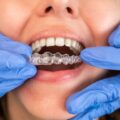Considering Invisalign as a solution to straighten your teeth? This post dives into the realities of using Invisalign, exploring its benefits and limitations to help you determine if it’s the right orthodontic treatment for your dental needs. Whether you’re concerned about aesthetics, cost, or the treatment process, we’ve got the insights you need to make an informed decision.
What is Invisalign?
Invisalign is an orthodontic treatment that uses clear plastic aligners to straighten teeth, offering a discreet alternative to traditional metal braces. The process involves wearing a series of custom-made aligners, each worn for about two weeks before moving to the next. This gradual transition gently shifts the teeth into the desired alignment, leading to a straighter smile.
What are the Benefits of Invisalign?
If you’re considering orthodontic treatment but are hesitant about the look and feel of traditional braces, Invisalign might be the solution for you. This innovative system offers many benefits, from enhanced aesthetics to increased comfort. Let’s explore some key advantages that make Invisalign an attractive choice for achieving a straighter smile.
Improved Aesthetics
One of the main advantages of Invisalign is its discreet appearance. The clear plastic aligners are virtually invisible when worn, allowing you to straighten your teeth without the noticeable presence of metal braces. This discreetness makes Invisalign a popular choice, especially for adults who might feel self-conscious about wearing traditional braces.
Removable Aligners
Invisalign aligners are designed to be removable, allowing you to take them out for eating, drinking, brushing, and flossing. This not only simplifies oral hygiene during treatment but also allows you to enjoy your favorite foods without restrictions. Plus, removing the aligners for special occasions or important meetings adds to the convenience.
Comfort and Convenience
The smooth plastic material used in Invisalign aligners is more comfortable than traditional braces, which often cause irritation due to metal wires and brackets. This can lead to a more pleasant orthodontic experience with fewer instances of sores or abrasions in your mouth. The ability to remove the aligners as needed also contributes to a more convenient treatment process, letting you maintain your regular lifestyle with fewer interruptions.
Is Invisalign Right for You?
When considering orthodontic treatment options, it’s important to understand whether Invisalign aligns with your specific needs and lifestyle. This will help you make an informed decision about your orthodontic journey. To get professional advice on Invisalign in Washington, DC, Kumra Orthodontics offers expert consultations to guide you through the decision-making process.
Suitability for Different Cases
Invisalign can treat a wide range of orthodontic issues, including crowded teeth, gaps, overbites, underbites, and crossbites. The aligners are designed to be versatile and adaptable, allowing them to address various dental concerns effectively. However, for more severe orthodontic cases, traditional braces may still be the best option, providing greater control over tooth movement and alignment.
Lifestyle Considerations
Before choosing Invisalign, it’s important to consider your lifestyle and your ability to follow the recommended treatment guidelines. Invisalign aligners need to be worn for 20-22 hours a day for optimal results, which may be challenging for some people. Additionally, those who participate in contact sports or frequently remove the aligners for eating or drinking should weigh the impact this might have on their treatment progress.
Consultation with a Professional
The best way to determine if Invisalign is right for you is to consult with a qualified orthodontic professional. During your consultation, the orthodontist will evaluate your orthodontic needs, lifestyle, and treatment goals to recommend the most suitable treatment plan.

This personalized approach ensures that you receive the best care and achieve the desired results, whether that means Invisalign or another form of orthodontic treatment.
What Potential Downsides Should You Consider Before Choosing Invisalign?
While Invisalign offers a discreet and flexible option for straightening teeth, there are some notable drawbacks that potential users should consider. Let’s examine a few of these challenges to help you make an informed decision about whether Invisalign is right for you.
Compliance and Discipline
Invisalign requires a high level of compliance from the patient, as the aligners must be worn for at least 22 hours each day to be effective. This can be challenging for those who frequently remove the aligners for eating, drinking, or other activities. Failure to adhere to this schedule can lead to extended treatment times and less predictable outcomes, undermining the effectiveness of the treatment.
Treatment Time
Invisalign treatment can sometimes take longer to achieve desired results compared to traditional braces. This is especially true in complex cases where more force is needed to move the teeth into alignment. The gentle pressure applied by Invisalign aligners may require additional sets and extended treatment, which can be frustrating for patients seeking a quicker resolution.
Cost Considerations
Invisalign often comes with a higher price tag compared to traditional braces, which can be a significant drawback for many patients.

The increased cost is due to the technology involved and the customized aligners, which are typically replaced every few weeks. While the benefits of Invisalign may justify the expense for some, others might find the cost prohibitive, making it less accessible compared to traditional orthodontic treatments.
Conclusion
Invisalign offers numerous benefits, including improved aesthetics, removable aligners, and enhanced comfort. However, it also comes with drawbacks such as the need for strict compliance, potentially longer treatment time, and cost considerations. When considering Invisalign, it’s essential to weigh these factors against your individual needs and lifestyle. Ultimately, the decision to choose Invisalign or traditional braces should be based on a thorough understanding of the benefits and drawbacks of each option, as well as guidance from a qualified orthodontic professional.
Jessica has a flair for writing engaging blogs and articles. She enjoys reading and learning new things which enables her to write different topics and fields with ease. She also strives to break down complex concepts and make them easy for anybody to comprehend.





